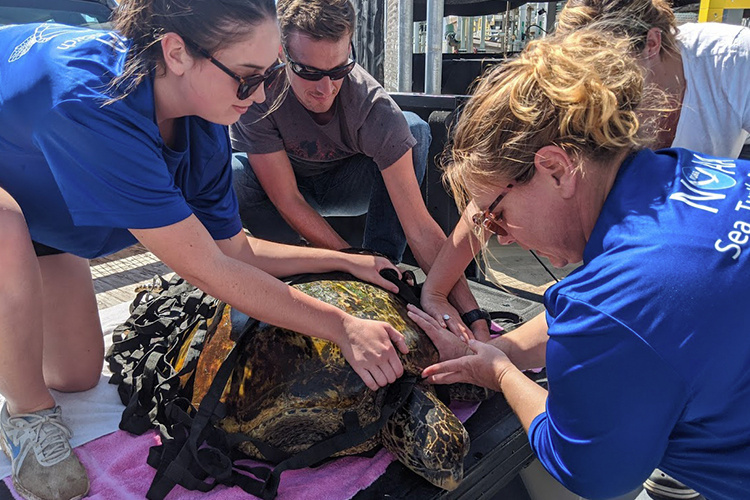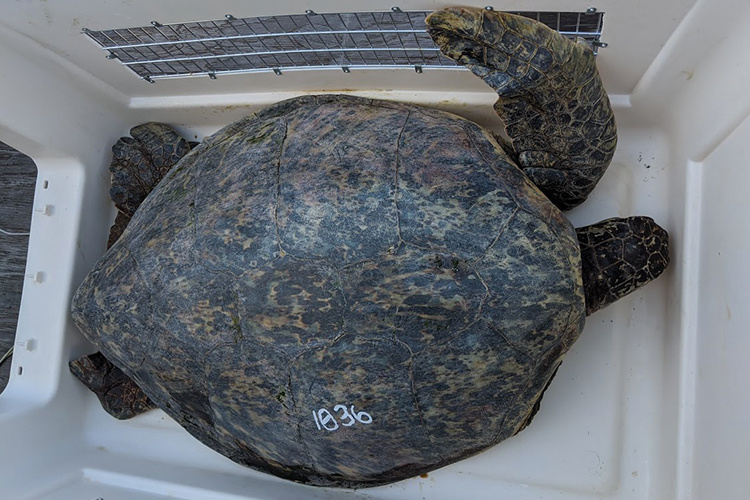Sea Turtles in the Pacific Islands Updates
Get the latest updates from NOAA Fisheries on sea turtles in Hawaiʻi and throughout the Pacific Islands region.
Final Programmatic Environmental Assessment and Associated Finding Of No Significant Impact Published
April 2024
NOAA Fisheries’ Pacific Islands Fisheries Science Center Marine Turtle Biology and Assessment Program has published a Final Programmatic Environmental Assessment (PEA) and associated Finding Of No Significant Impact (FONSI) to the NOAA institutional repository.
On April 13, 2023, NOAA Fisheries published the draft PEA to the Pacific Islands Region NEPA website and provided a 30-day public review and commenting period between April 13, 2023–May 12, 2023. NOAA Fisheries also notified the public of the availability of the draft PEA by announcing it on the NOAA Fisheries Sea Turtle Updates webpage, by emailing over 80 relevant stakeholders, and posting an announcement on the C-Turtle listserv. During this time, we received public comments from two parties. These comments and our responses are summarized in the final PEA.
This final PEA analyzes the effects of the Marine Turtle Biology and Assessment Program’s ongoing research activities on sea turtles and the environment, including:
- Monitoring population trends
- Exploring the use of advanced technology for research and monitoring
- Developing the application of simulation modeling of population dynamics using long-term datasets
- Stranding response and research
- Training and capacity building
- Education and outreach efforts to inform and build support from the public
New research activities analyzed in this PEA include nest probing and nest relocations, which would be subject to permit approval.
The FONSI determined that NOAA Fisheries’ Pacific Islands Fisheries Science Center Marine Turtle Biology and Assessment Program’s sea turtle research will not significantly impact the quality of the environment.
Kauaʻi Honu Nest Excavation Reveals a Very Successful Hatching
November 2023
On paper, the Pacific Missile Range Facility Barking Sands appears to be an ideal location for any honu, or green sea turtle, looking to lay her nest. It lacks light pollution that could disorient hatchlings looking for the sea, and its limited human activity and land-based predators, like cats or rats, mean it's generally tranquil. And for at least one honu, the Kauaʻi site turned out to be the right nesting choice to give her babies the best chance of survival.
In mid-September, a nest of green sea turtles at Barking Sands hatched after incubating for 56 days. A week later, Jamie Thomton, NOAA Fisheries Kauaʻi Marine Wildlife Response Coordinator, joined Hawaiʻi Department of Land and Natural Resources and U.S. Navy biologists to excavate the nest. They uncovered 76 hatched green sea turtle eggs, along with four unhatched nonviable eggs. This is excellent hatch success for a nest. A careful search of the beach yielded no signs of the hatchlings, indicating they likely made it to sea safely!
NOAA Pacific Islands Fisheries Science Center Marine Turtle Biology and Assessment Program publishes a draft Programmatic Environmental Assessment
April 2023
NOAA Fisheries’ Pacific Islands Fisheries Science Center (PIFSC) Marine Turtle Biology and Assessment Program (MTBAP) has published a draft programmatic environmental assessment (PEA) on our region’s NEPA website. This PEA analyzes the effects of MTBAP’s ongoing research activities on sea turtles and the environment, including monitoring population trends, exploring the use of advanced technology for research and monitoring, developing the application of simulation modeling of population dynamics using long-term datasets, stranding response and research, training and capacity building, and education and outreach efforts to inform and build support from the public. New research activities in this PEA include nest probing and nest relocations.
The PEA will be available for public comment for 30 days. If you choose to review the document and would like to submit comments, please send them to Laura Mccue between April 13 and May 12, 2023.
Community and Researchers Rally Around Sea Turtles on Kaua‘i
January 2023
Recently, our NOAA sea turtle biologists partnered with the Hawai‘i Department of Land and Natural Resources (DLNR), Division of Aquatic Resources (DAR), and the non-profit Mālama i nā Honu to tag sea turtles resting on Kaua‘i beaches. They tagged more than 50 turtles! More importantly, they provided technical training and helped build the local capacity of partners to independently continue tagging activities and community-based outreach. This work will be done in coordination with permitted biologists from NOAA and DLNR.
Sea turtles are known to bask (rest) at Poʻipū. The number of turtles there has increased in recent years from 2–3 turtles per night to often more than 70! This provides a unique opportunity for researchers to improve our scientific understanding of the turtle population and conduct outreach to onlookers.
The trip also coincided with the 1-year anniversary of Mālama i nā Honu’s stewardship at Poʻipū beach. Volunteers provide educational outreach to visitors (almost 500 people per night!) and help reduce public disturbance to basking turtles. Local residents have really stepped up to “mālama” (care for) the turtles at Poʻipū. Supported by the expertise and guidance of Mālama i nā Honu team members from Oʻahu, residents have built a dedicated community-based volunteer program on Kauaʻi.
“The level of community engagement at Poʻipū in just one short year is a huge management success story,” said Irene Kelly, NOAA Fisheries sea turtle recovery coordinator. “It’s a win-win for basking turtles, visitors, the visitor industry, local businesses, lifeguards (who no longer need to police negative human/turtle interactions), and residents.”
Sea Turtle Gets a Second Chance at a Long Life
January 31, 2020

As an important part of our island culture, fishing in Hawai`i brings families and friends together in common purpose and connection. But sometimes our fishing activities can have unintended consequences for curious reef-dwelling critters. Luckily, potentially unfortunate situations can turn around when people work together.
Such was the case when a large adult male Hawaiian green sea turtle (honu) was found with an injured flipper in Waialua. The public called the statewide marine animal stranding number, initiating a chain of actions to help the injured turtle.
Field responders with the Hawai`i Marine Animal Response, recognizing that the animal needed specialized attention, brought the honu to NOAA Fisheries for veterinary care. Our veterinary staff found the turtle had a monofilament fishing line deeply embedded into its front flipper, requiring the appendage to be amputated.
The honu underwent two weeks of rehabilitation at the NOAA Daniel Inouye Regional Center under the care of the Marine Turtle Biology and Assessment Program. On January 30, 2020, we returned the turtle home to Waialua. Dr. Summer Martin, the programs’ leader, confirms that fishing gear-related injuries and deaths continue to increase.
“Our program has been monitoring the population since 1982,” Martin explains, “and monofilament line entanglement from coastal hook-and-line fisheries is currently the primary threat observed in sea turtle strandings in Hawai`i.”
The turtle has been marked with a temporary number—1036—etched on his shell. Waialua residents might see him swimming around. If you see him, please report the sighting (to respectwildlife@noaa.gov) so we can keep track of his healing progress.

“He now has a second chance for a long life,” says Irene Kelly, sea turtle recovery coordinator at the NOAA Fisheries Pacific Islands Regional Office. Sea turtles can get accidentally snagged on active gear or entangled in gear lost on the reef. NOAA and Hawai`i State Department of Land and Natural Resources reminds the public to help minimize gear left on the reef. And if you accidentally catch a turtle—and it's safe for both you and the turtle—help to prevent deadly entanglement by following these steps:
- Call (888) 256-9840, the Marine Animal Response Hotline for guidance.
- Reel-in turtle with care. Do not drag a turtle up a cliff.
- Hold turtle by its shell.
- Cut line close to hook, or as short as possible. Leave the hook in place.
- Release with no line attached.
“We thank the many partners that helped make this a success story, including the community for their initial report, the local non-profit HMAR, and researchers at NOAA Fisheries,” Kelly says “And thanks to HMAR, we are also sending him off with a Hawaiian blessing in hopes that he will continue to thrive in Waialua for many decades to come.”
For marine animals in distress, call the statewide hotline to report emergencies for sea turtles, monk seals, dolphins, and whales: (888) 256-9840 and (for non-emergencies) email: respectwildlife@noaa.gov.
Learn more about fishing around seals and turtles (FAST) program




